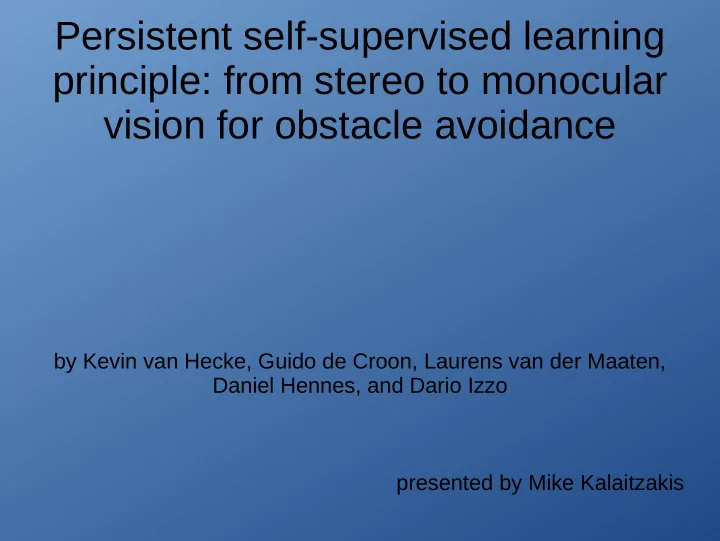

Persistent self-supervised learning principle: from stereo to monocular vision for obstacle avoidance by Kevin van Hecke, Guido de Croon, Laurens van der Maaten, Daniel Hennes, and Dario Izzo presented by Mike Kalaitzakis
What is Persistent Self-Supervised Learning? ● What is Self- Supervised Learning ● What makes this persistent ● Differences and Similarities between other ML methods ● What are the advantages https://xkcd.com/1838/
What is Persistent Self-Supervised Learning? ● Self-Supervised Learning is a mechanism that uses a trusted sensor cue for training to recognize a complementary sensor cue
What is Persistent Self-Supervised Learning? ● Persistent Self- Supervised Learning is a Self- Supervised Learning method where the goal is to be able to replace the original trusted sensor cue if necessary
What is Persistent Self-Supervised Learning? ● Shares some similarities with Unsupervised Learning (UL) and Learning from Demonstration (LfD) ● Does not need labeled data like UL ● Does not need an external “teacher” as LfD ● Does not need a reward function and many trial-and-error sessions as Reinforcement Learning ● Can autonomously decide which sensor cue to use or if re-training is needed
Going from Stereo Vision to Monocular Vision ● The disparity is the difference between the same image feature in the two images of a calibrated stereo pair ● It is used to calculate the distance of an object from the cameras Stefano Mattoccia, University of Bolona ● A 4-gram custom made stereo camera is used (128x96 pixel, 10fps) ● The PSSL tries to estimate the average disparity and not the whole map TU Delft, MAV-Lab
Visual Bag of Words (VBoW) and Textons ● In VboW a complex image is split in small image patches ● A dictionary is created by clustering the patches called textons ● When processing an image each patch is compared to the dictionary creating a texton occurrence histogram ● Both intensity and gradient textons are used
Why Visual Bag of Words? ● Short Answer: Computationally efficient and limited computational power platform (Parrot AR Drone 2, 1GHz ARM cortex A8, 128MB RAM) ● Compared to the best available CNN the results were comparable and depended on the dataset
System Overview ● Binary classification ● Determine the threshold (t λ ) from the ROC curve ● The threshold is chosen to minimize the probability of collision ● Since the data cannot be assumed identically and independently distributed a Markov process was used to model the system ● PSSL limitation factor: By design the system will encounter very few occasions where obstacles are detected
System Overview
Simulation Results ● SmartUAV simulation environment was used to choose regression method and learning scheme ● kNN, Linear regression, Gaussian process and Neural Networks were tested ● “Cold Turkey”, DAgger and “Training wheels” approaches to learning were tested
Experiment Results
ISS Video
Recommend
More recommend